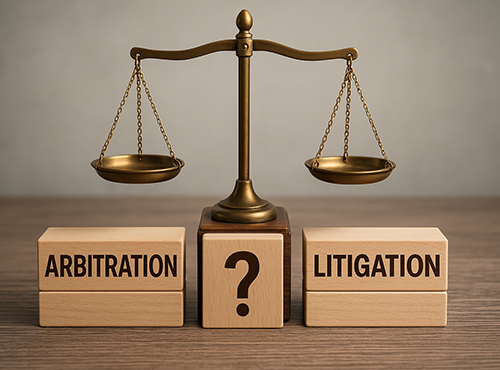Transfer Petition
A transfer petition is a formal request made before a higher court to move a pending case from one court to another. In simple terms, it is a petition for transfer of legal proceedings when one party feels that justice may be better served in a different jurisdiction. Such petitions are most commonly seen in transfer of cases from one court to another, either due to convenience of parties, apprehension of bias, or in the interest of justice.

The importance of a transfer petition in the Indian legal system lies in its role as a safeguard to ensure fair trial, impartiality, and accessibility. For instance, if a litigant believes that continuing a case in a particular court may lead to prejudice or undue hardship, they can seek relief through a transfer petition in High Court or in Supreme Court depending on the nature of the case.
The concept is legally recognized and codified. In civil matters, the transfer petition under CPC (Code of Civil Procedure, 1908) empowers the Supreme Court under Section 25 and the High Courts under Section 24 to move cases between courts. In criminal matters, the transfer of criminal cases under CrPC (Code of Criminal Procedure, 1973) allows higher courts to shift proceedings to ensure justice and fair play.
To initiate this process, parties usually prepare a transfer petition form, supported with reasons and documents, which is then submitted to the concerned court. The higher court evaluates the merits before deciding whether the case should indeed be shifted.
In essence, the transfer petition mechanism is a cornerstone of India’s justice delivery system, empowering litigants to seek impartiality and convenience while reinforcing the constitutional promise of equality before the law.
What is a Transfer Petition?
A transfer petition is a formal legal remedy available to parties who seek the transfer of cases from one court to another for reasons such as convenience, fairness, or fear of bias. In simple terms, it is a petition for transfer that requests a higher court to move an ongoing case from its current jurisdiction to another court better suited to handle it. This provision plays an important role in safeguarding the principles of justice and ensuring that no party suffers due to geographical, personal, or legal disadvantages.
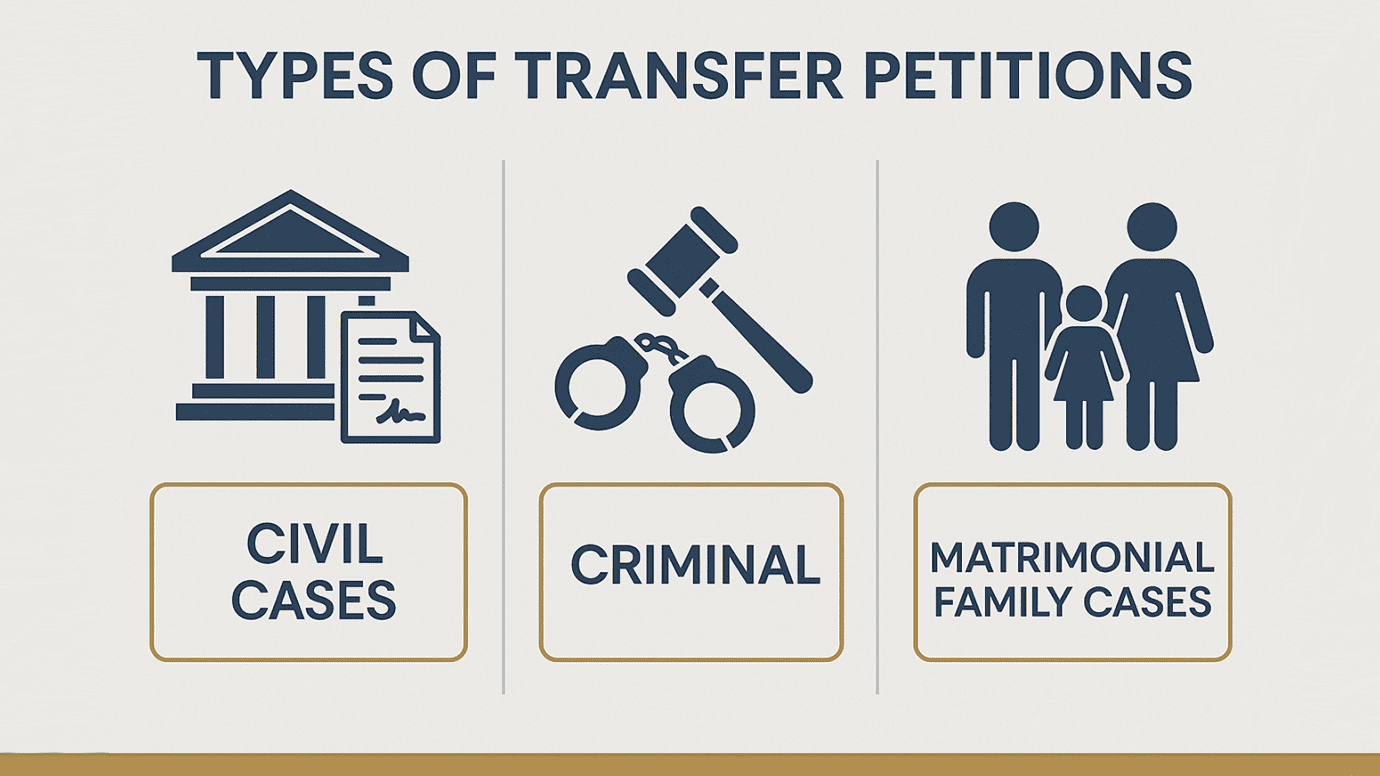
Types of Transfer Petitions
Civil Cases
- A transfer petition under CPC (Code of Civil Procedure, 1908) allows litigants to move civil matters between courts.
- This may include disputes related to contracts, property, commercial disagreements, or transfer of divorce petition in family courts.
- The grounds for transfer petition in civil matters often include convenience of parties, avoidance of conflicting judgments, or apprehension of prejudice.
Criminal Cases
- In criminal proceedings, the transfer of criminal cases under CrPC (Code of Criminal Procedure, 1973) gives the Supreme Court or High Court the power to shift trials to another jurisdiction.
- This is especially relevant when impartiality of trial is in question, or when witnesses and evidence are located far away from the current court.
- The process is commonly referred to as transfer of criminal cases, and it ensures that the accused, complainant, and witnesses all have a fair opportunity to participate in the proceedings.
Family and Matrimonial Disputes
- One of the most frequent uses of a transfer petition is in matrimonial disputes, such as divorce and custody battles.
- A transfer petition in matrimonial cases may be filed when one spouse, often the wife, seeks to move the case to a court nearer to her place of residence for reasons of safety, convenience, or financial limitations.
- Courts are particularly sensitive in these matters and often allow the transfer of divorce petition to avoid hardship to the parties.
In essence, a transfer petition is not just about moving a case geographically — it is about ensuring accessibility, fairness, and justice for all parties involved. By providing a structured legal mechanism, the system ensures that no one is denied justice due to bias, inconvenience, or procedural hurdles.
Legal Provisions Governing Transfer Petitions
The power to allow a transfer petition is vested in the higher judiciary to ensure justice, convenience, and impartiality. Both the Supreme Court of India and the High Courts have specific authority to entertain a petition for transfer under different statutory provisions. These provisions clearly outline when and how the transfer of cases from one court to another can be granted.
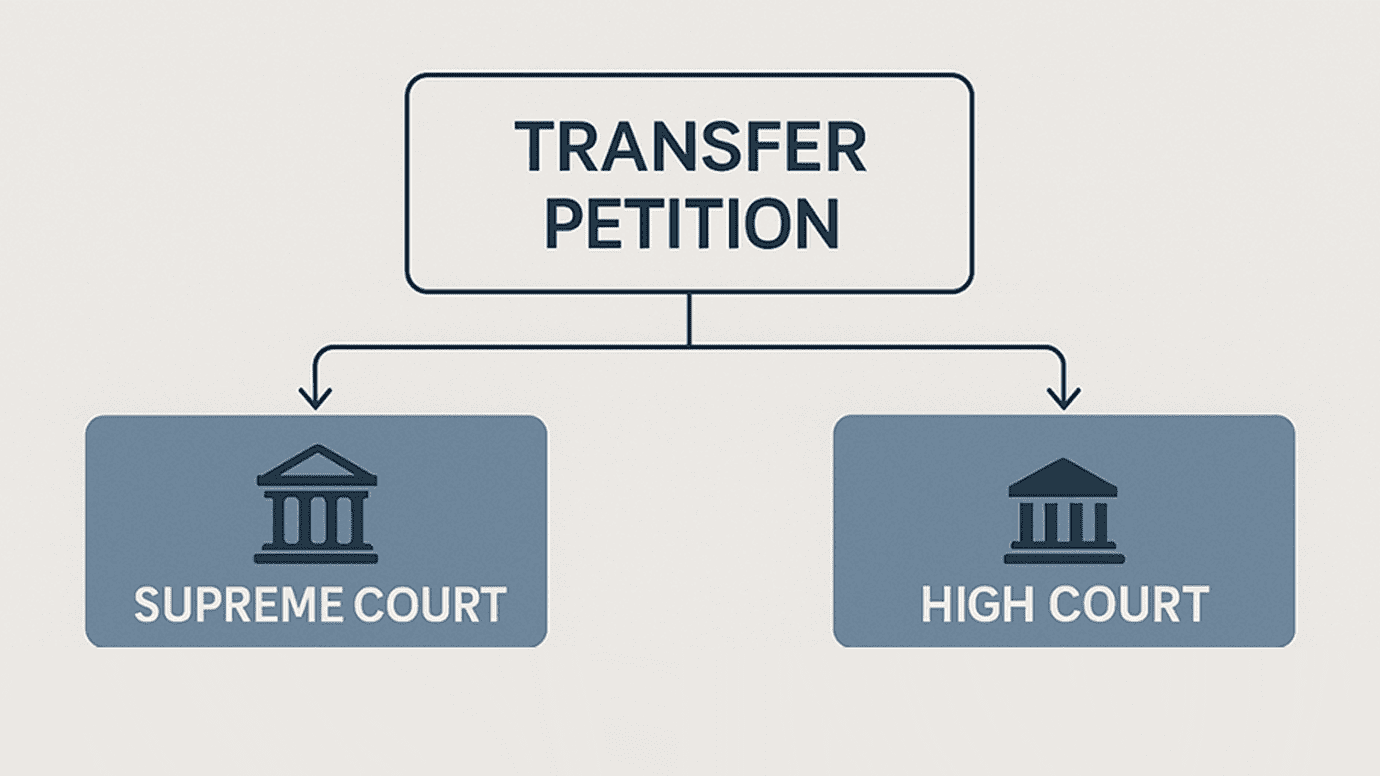
Supreme Court Powers
Article 139A of the Constitution of India
- This article empowers the Supreme Court to withdraw cases pending in different High Courts if they involve the same or substantially similar questions of law.
- This ensures uniformity of judicial interpretation and avoids contradictory judgments.
Section 25 of the Code of Civil Procedure (CPC), 1908
- A transfer petition under CPC may be filed directly before the Supreme Court when a civil matter needs to be shifted from one High Court to another, or from one state’s jurisdiction to another.
- The Supreme Court has the discretion to allow such transfers if it serves the interests of justice or convenience of parties.
Section 406 of the Code of Criminal Procedure (CrPC), 1973
- For criminal matters, the transfer petition under CrPC is filed before the Supreme Court under Section 406.
- This provision governs the transfer of criminal cases under CrPC, enabling the apex court to move trials or appeals from one High Court or criminal court to another across the country.
High Court Powers
Section 24 of the CPC, 1908
- A transfer petition in High Court under Section 24 CPC deals with civil matters within the state.
- The High Court has authority to transfer cases between district courts, family courts, and subordinate civil courts.
- This includes shifting matrimonial disputes, property disputes, and commercial suits when necessary.
Section 407 of the CrPC, 1973
- For criminal proceedings within the state, transfer of criminal cases can be ordered by the High Court under Section 407.
- This ensures that if there is a reasonable apprehension of bias, safety concerns, or inconvenience, the trial can be moved to another jurisdiction within the state.
Significance of Legal Provisions
These provisions collectively ensure that the transfer petition mechanism is not misused, but is available as a vital safeguard for litigants. By allowing the transfer of criminal cases and civil disputes to the most appropriate jurisdiction, the courts uphold the constitutional guarantee of fair trial and equal access to justice. Whether through a transfer petition in Supreme Court under Article 139A, Section 25 CPC, or Section 406 CrPC, or through a transfer petition in High Court under Section 24 CPC and Section 407 CrPC, the objective remains the same — to maintain impartiality, convenience, and justice.
Who Can File a Transfer Petition?
A transfer petition is not limited to a particular category of litigants — any party to the case can file a petition for transfer if they can establish valid grounds for it. The law recognizes the right of every individual or entity involved in a proceeding to seek fairness, convenience, and justice by transferring a case from one court to another.
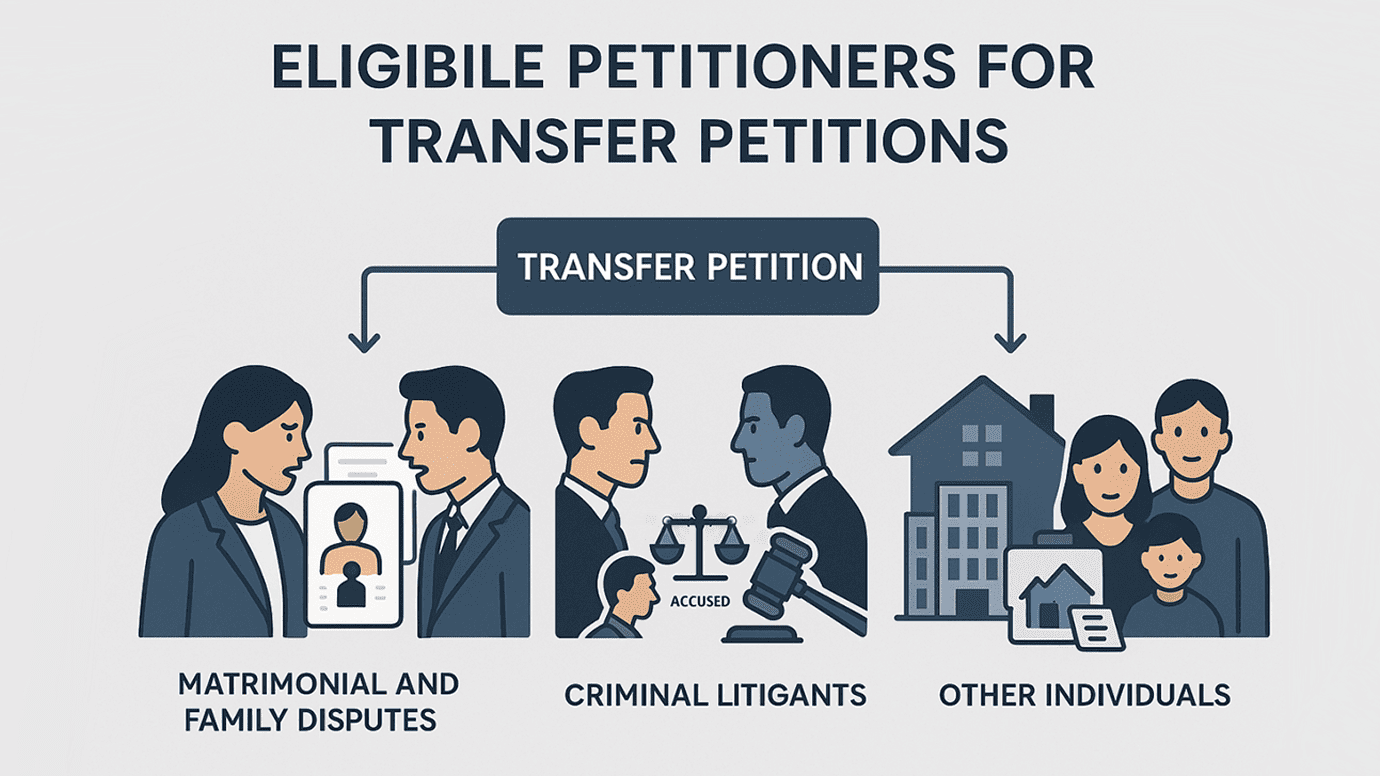
Parties in Matrimonial and Family Disputes
- One of the most common scenarios involves matrimonial disputes, especially divorce and custody cases.
- A transfer petition in matrimonial cases may be filed by either spouse, though it is often filed by the wife seeking a transfer of divorce petition to a court closer to her place of residence.
- However, not all requests are accepted. For instance, there have been cases where a transfer petition by wife dismissed due to insufficient grounds, reminding litigants that convenience alone may not always be enough.
- These petitions are usually governed under Section 24 CPC (civil matters in High Courts) or Section 25 CPC (before the Supreme Court).
Litigants in Criminal Matters
- Both the complainant and the accused can file a transfer petition under CrPC if they believe they cannot expect a fair trial in the current jurisdiction.
- Under Section 406 CrPC, the transfer petition in Supreme Court allows for the transfer of criminal cases from one state to another.
- Under Section 407 CrPC, the transfer petition in High Court ensures the transfer of criminal cases within the state when issues like bias, security, or inconvenience arise.
Corporations and Commercial Disputes
- Companies and business entities often rely on a petition for transfer in commercial disputes to avoid multiplicity of proceedings in different jurisdictions.
- For example, when similar cases are filed in multiple states, a corporation may request the transfer of cases from one court to another to streamline litigation and avoid conflicting judgments.
Other Eligible Petitioners
- Individuals involved in property disputes, inheritance matters, consumer disputes, and arbitration cases can also approach the higher courts.
- In each scenario, the party seeking transfer must submit a properly drafted transfer petition form along with supporting documents and justifications.
Whether it is a transfer petition under CPC for civil cases or a transfer petition under CrPC for criminal matters, the eligibility is broad: husband, wife, complainant, accused, or even corporate entities may approach the court. What ultimately matters are the grounds for transfer petition, such as convenience, safety, impartiality, or judicial efficiency.
By giving this right to all litigants, the legal system ensures that the mechanism of transferring a case from one court to another is not restricted, but available to anyone seeking a fair opportunity to present their case.
Grounds for Filing a Transfer Petition
Courts do not allow a transfer petition casually. The judiciary carefully examines the grounds for it to ensure that the request for transferring a case from one court to another is genuine and not an attempt to delay proceedings. Whether the application is a transfer petition in Supreme Court or in High Court, the following grounds are commonly accepted.
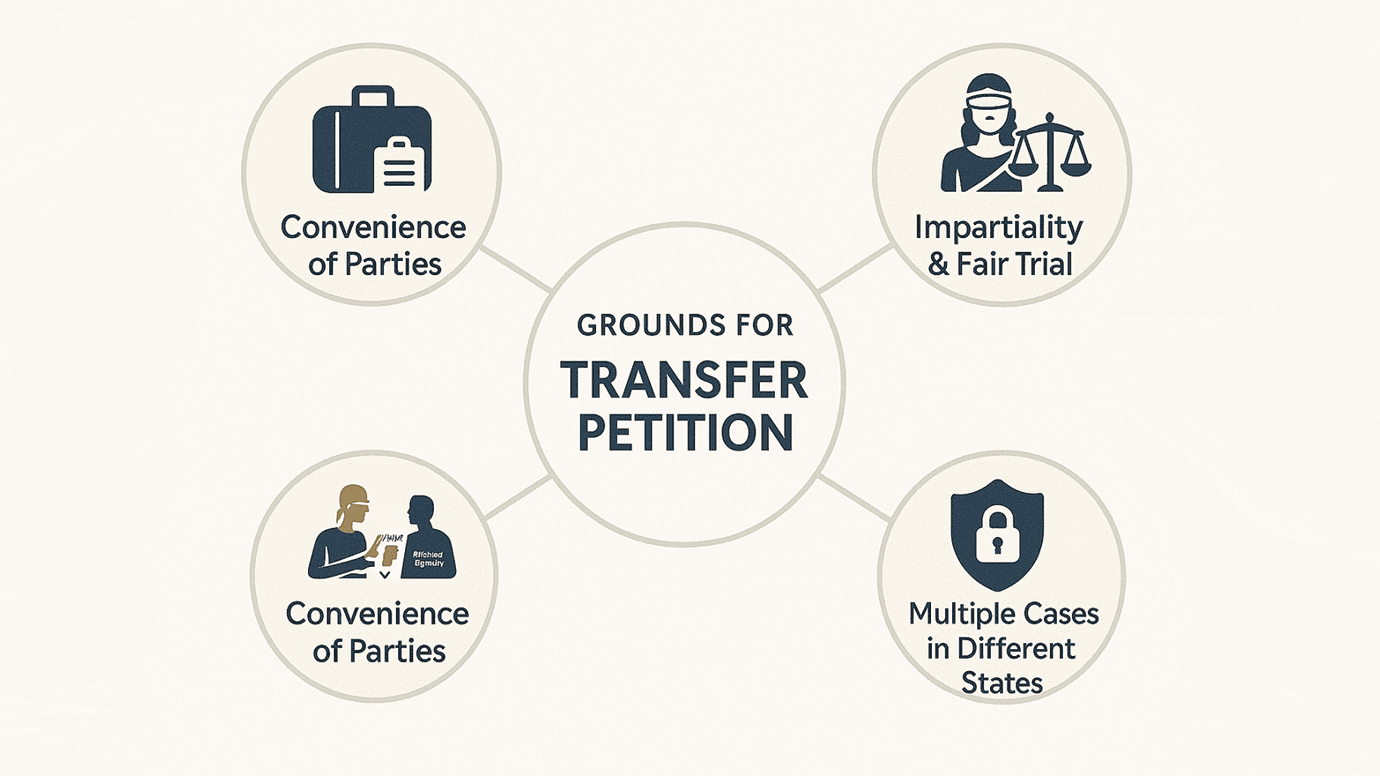
- Convenience of Parties: One of the most common grounds for transfer petition is the convenience of parties. For example, if a wife lives in a different city and is unable to travel frequently due to financial or health reasons, she may seek a petition for transfer of her matrimonial dispute. Courts often prioritize the convenience of women and dependent parties to avoid undue hardship.
- Impartiality and Fair Trial Concerns: A cornerstone of justice is impartiality. If a litigant has a reasonable apprehension that the current court may be biased or influenced, they can file a transfer petition in Supreme Court or in High Court. For instance, if one party has strong local influence in a particular jurisdiction, the other party can request the transfer of cases from one court to another to ensure a fair and neutral trial.
- Safety and Security Issues: When personal safety or security of the parties or witnesses is at stake, the higher courts may allow transferring a case from one court to another. This is particularly relevant in criminal cases, where threats, intimidation, or hostile environments could prevent a fair trial. A transfer petition in such cases protects the dignity of the legal process and ensures that witnesses can testify freely without fear.
- Multiple Cases in Different States: Sometimes, related cases are pending in different states or jurisdictions. To avoid duplication of efforts and conflicting judgments, a transfer petition in Supreme Court may be filed to consolidate these matters in a single court. This ground helps streamline litigation, reduce costs, and bring uniformity in the outcome.
The grounds for transfer petition must always be supported with credible reasons and evidence. Courts are cautious because the transfer of cases from one court to another directly affects the administration of justice. Hence, while convenience, impartiality, safety, and judicial efficiency remain strong grounds, frivolous or vague claims are likely to be dismissed.
Procedure to File a Transfer Petition
Filing a transfer petition is a systematic process governed by clear rules of procedure. Whether a litigant is approaching the Supreme Court or the High Court, the steps remain broadly similar. A petition for transfer must be properly drafted, supported with evidence, and presented in a way that convinces the court that the request is genuine and based on valid grounds.
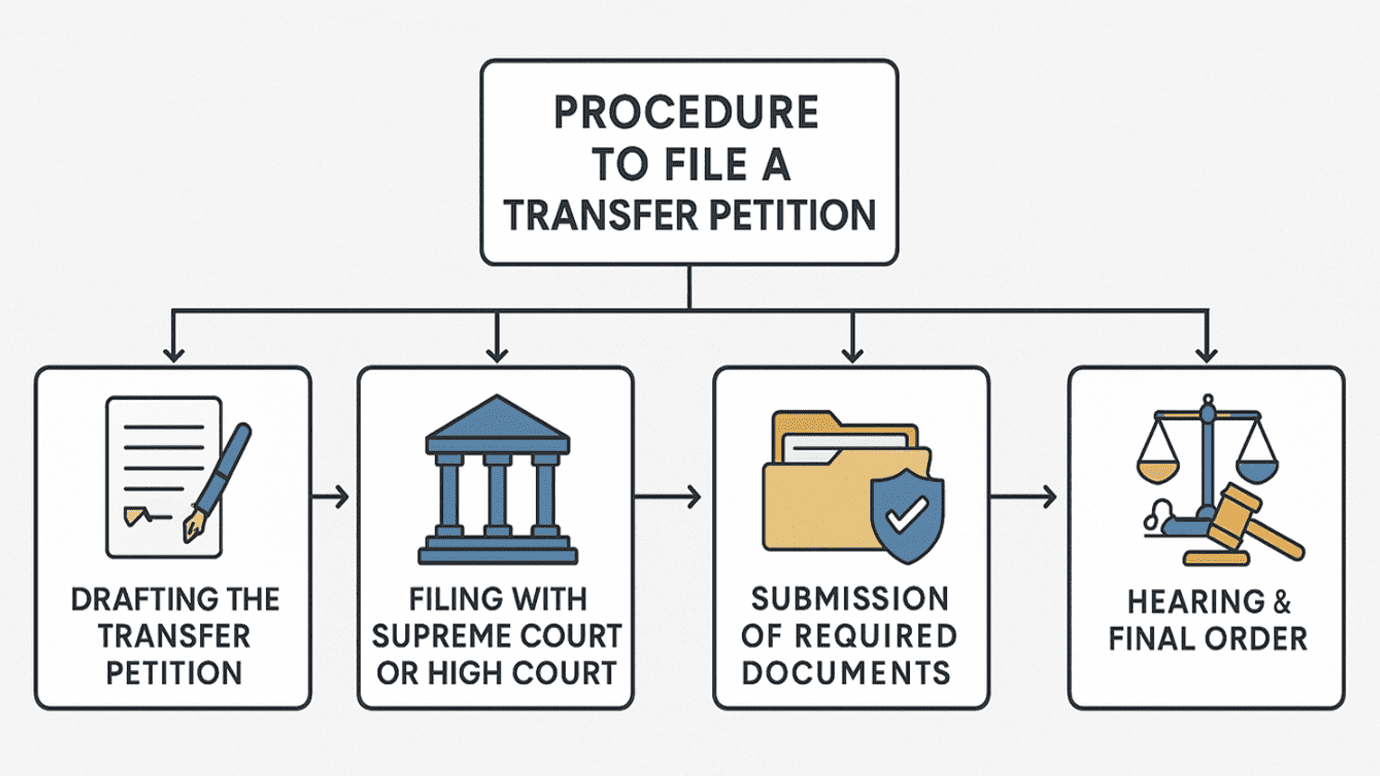
Step 1: Drafting the Transfer Petition
- The process begins with preparing a detailed petition for transfer, stating why the case should be shifted from its current jurisdiction.
- The petition must clearly specify the existing court, the court to which the transfer is sought, and the reasons — such as convenience, fair trial concerns, or safety issues.
- Lawyers often cite precedents, including the latest judgment on transfer petition, to strengthen the arguments.
Step 2: Filing with Supreme Court or High Court
- If the case involves inter-state transfer (from one High Court to another or from one state’s jurisdiction to another), the application is filed as a transfer petition in Supreme Court.
- If the case is limited to movement within a state (between district courts or subordinate courts), the application is filed as a transfer petition in High Court.
Step 3: Submission of Required Documents
- A valid transfer petition must be accompanied by supporting documents, such as:
- Certified copy of the case file.
- Affidavit explaining the reasons for transfer.
- Any relevant supporting evidence (e.g., medical certificates, proof of residence, or security threats).
- Courts may also require a transfer petition form to be filled with basic details of the case.
Step 4: Notice to the Opposite Party
- Once the petition is filed, the court issues a notice to the opposite party, giving them an opportunity to contest the request.
- Both sides are allowed to present arguments before the court decides whether the transfer petition is justified.
Step 5: Hearing and Final Order
- The court examines the facts, evidence, and arguments presented.
- Past rulings, including the latest judgment on transfer petition, are often relied upon to determine whether the grounds raised are sufficient.
- The court then passes a final order either granting or rejecting the transfer petition. If granted, the case is officially moved to the new jurisdiction
The procedure to file a transfer petition is designed to protect the rights of litigants while preventing misuse of the process. By ensuring proper drafting, submission of supporting documents, and giving both parties an opportunity to be heard, the courts maintain fairness and transparency.
Challenges and Limitations with Transfer Petition
While the law provides the remedy of a transfer petition, it is not granted automatically. Courts exercise this power with extreme caution to prevent misuse. Litigants must understand the practical challenges and limitations before filing.
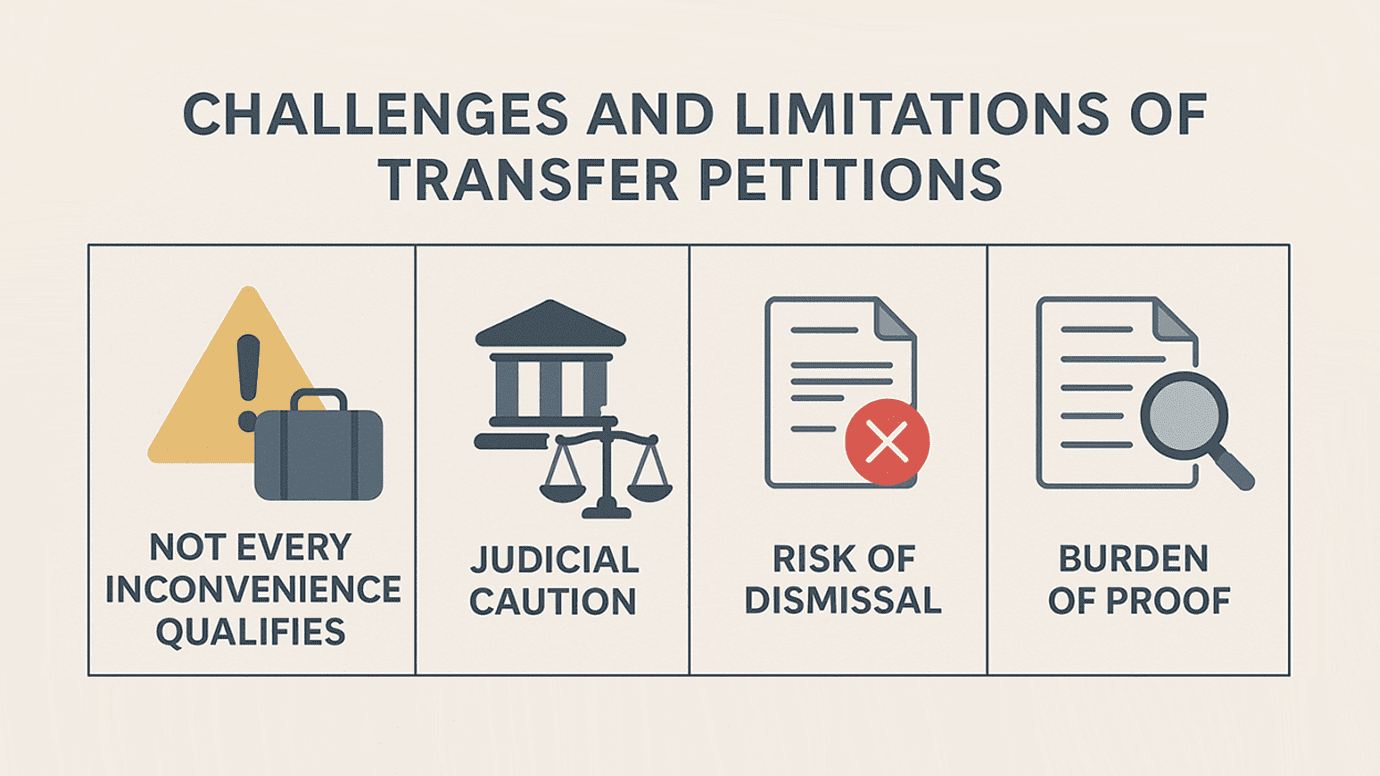
- Not Every Inconvenience Qualifies: One of the biggest limitations is that mere inconvenience — such as longer travel distance or personal discomfort — may not be enough. The grounds for transfer petition must be substantial, such as apprehension of bias, safety threats, or genuine hardship. Courts look for credible reasons backed by evidence rather than vague claims.
- Judicial Caution in Granting Transfers: The judiciary is aware that a transfer petition can sometimes be used as a delay tactic. To prevent unnecessary disruption of ongoing trials, courts grant transfers only when the balance of convenience and justice clearly favors it. This cautious approach ensures that the right to a fair trial is upheld without overburdening the judicial system.
- Risk of Dismissal for Malicious or False Claims: If a litigant files a transfer petition with false, exaggerated, or malicious grounds, the court has the power to dismiss it outright. In some cases, costs may also be imposed on the petitioner. This serves as a warning that only genuine and reasonable grounds for transfer petition will be entertained.
- Burden of Proof Lies on the Petitioner: It is the petitioner’s responsibility to establish why transferring the case is necessary. This requires clear documentation, affidavits, and sometimes corroborating evidence. Without strong proof, the court is unlikely to allow the request.
The provision of transfer petitions is a powerful safeguard for justice, but it cannot be misused as a tool to delay proceedings or harass the opposite party. Courts balance convenience with judicial efficiency, ensuring that only legitimate grounds for transfer petition are recognized.
How a Lawyer Can Help in Transfer Petitions
Filing a transfer petition is not just about asking the court to move a case — it involves careful legal reasoning, proper documentation, and strong courtroom advocacy. A skilled lawyer plays a crucial role in ensuring that a petition for transfer is presented effectively, increasing the chances of success.
- Importance of Proper Drafting: The strength of a transfer petition begins with precise drafting. Lawyers know how to clearly outline the grounds for transferring a case from one court to another, cite relevant provisions, and support the request with legal precedents. A poorly drafted application risks being dismissed at the very first stage. With professional drafting, however, the transfer petition form reflects both legal accuracy and persuasive reasoning.
- Strategic Advice on Jurisdiction: A lawyer can assess whether the case requires a petition for transfer in the Supreme Court (for inter-state matters) or the High Court (for transfers within the same state). Choosing the wrong jurisdiction can delay justice. Experienced advocates provide the right strategy by analyzing factors like convenience, impartiality, and judicial efficiency before deciding where to file the petition.
- Representing Clients in Higher Courts: Whether it is the Supreme Court or a High Court, oral arguments matter as much as written submissions. A lawyer not only files the transfer petition but also presents persuasive arguments during hearings. They anticipate objections from the opposite party and ensure that the client’s right to a fair trial is strongly defended.
- Ensuring Compliance with Legal Procedure: From preparing the transfer petition form to attaching supporting affidavits and documents, every procedural step must be followed correctly. Lawyers help avoid technical errors that could otherwise weaken the petition for transfer. Their expertise ensures that the petition complies with court rules and is processed without unnecessary delays.
Engaging a qualified lawyer gives litigants a decisive advantage in transfer petitions. From drafting and filing to strategic planning and courtroom representation, legal professionals ensure that the process of transferring a case from one court to another is smooth, credible, and effective.
FAQs
A. A transfer petition is a formal petition filed before the Supreme Court or High Court to request the transfer of cases from one court to another. It ensures justice, fairness, and convenience when continuing in the current court may cause hardship or bias.
A. Any party to a case — complainant, accused, husband, wife, or even companies in commercial disputes — can file a transfer petition. For example, in family disputes, a wife may file a transfer petition in matrimonial cases for the transfer of divorce case to a more convenient court.
A.The most accepted grounds for transfer petition include:
- Convenience of parties
- Impartiality and fair trial concerns
- Safety/security issues
- Multiple cases pending in different states that risk conflicting judgments
A. A transfer petition in Supreme Court is filed when cases need to be shifted across different states or High Courts. Under Section 25 CPC for civil cases and Section 406 CrPC for criminal matters, the Supreme Court can order transferring a case from one court to another in the interest of justice.
A. A transfer petition in High Court is filed when the transfer is required within the same state, such as from one district court to another. Under Section 24 CPC, High Courts handle transfer petition in civil cases, while under Section 407 CrPC, they decide on the transfer of criminal cases within the state.
A. A valid transfer petition form must be supported with documents such as a certified copy of the case file, affidavits, and evidence proving the need for transferring a case from one court to another. This documentation strengthens the petitioner’s request.
Conclusion
The remedy of a transfer petition is one of the most effective safeguards in the Indian legal system, ensuring that justice is not compromised by inconvenience, bias, or safety concerns. Whether it is a civil matter requiring a transfer petition under CPC, a criminal trial needing transfer of criminal cases under CrPC, or a family dispute involving transferring a case from one court to another, the law provides a structured mechanism to protect litigants.
Filing a petition for transfer is not limited to one category of cases — it can cover matrimonial disputes, property conflicts, commercial matters, or even the transfer of criminal cases. Depending on the circumstances, one can file a transfer petition in Supreme Court for inter-state matters or a transfer petition in High Court for intra-state issues. What matters most is presenting strong and valid grounds for transfer petition supported by credible evidence.
It is important to remember that not every request for transfer of cases from one court to another is allowed. Courts exercise caution and grant such petitions only when fairness, impartiality, and justice truly demand it. This is why professional assistance matters. From preparing the transfer petition under CrPC or CPC, to drafting documents and representing clients in higher courts, an experienced advocate ensures that the process of transferring a case from one court to another is smooth and effective.
If you are considering filing a transfer petition, consult seasoned legal professionals who can evaluate your case, identify the right jurisdiction, and guide you through the process. With proper legal advice, your rights can be safeguarded, and justice can be secured without unnecessary delays. For more information regarding different cases, you can go to our Homepage.
Disclaimer:
This blog is intended solely for educational and informational purposes. It should not be construed as legal advice or relied upon as such. The process and outcome of a transfer petition — whether a transfer petition in Supreme Court, transfer petition in High Court, or the transfer of criminal cases under CrPC — may vary depending on the facts, evidence, and circumstances of each case.
If you are considering filing a petition for transfer, it is strongly recommended to consult a qualified lawyer or legal professional who can provide personalized advice based on your situation. For safe, reliable, and confidential guidance, you may also reach out to trusted legal platforms such as Adlegal.


